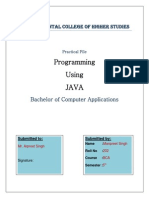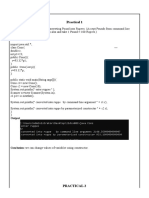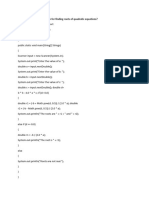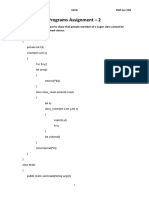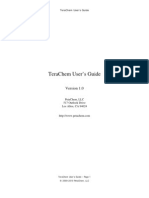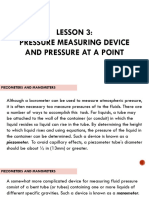1. Write a Java program to create a class called Shape with a method called getArea().
Create a subclass called
Rectangle that overrides the getArea() method to calculate the area of a rectangle.
public class Shape
{
public double getArea()
{
// Return 0.0 as the default area
return 0.0;
}
}
// Define the child class Rectangle that extends Shape
public class Rectangle extends Shape
{
private double length;
private double width;
// Define the constructor that takes length and width as parameters
public Rectangle(double length, double width)
{
this.length = length;
this.width = width;
}
// Use the @Override annotation to indicate that this method overrides a method in the superclass
@Override
// Define the getArea method that returns a double
public double getArea()
{
return length * width;
}
}
public class Main
{
public static void main(String[] args) {
// Create an instance of Rectangle with length 3.0 and width 10.0
Rectangle rectangle = new Rectangle(3.0, 10.0);
// Call the getArea method on the rectangle instance and store the result in the area variable
double area = rectangle.getArea();
// Print the area of the rectangle to the console
System.out.println("The area of the rectangle is: " + area);
}
}
Output:
The area of the rectangle is: 30.0
2. Write a Java program to create a class called Employee with methods called work() and getSalary()
1
public class Employee
{
private int salary;
public Employee(int salary)
{
this.salary = salary;
}
// Method to simulate the employee working
public void work()
{
// Print a message indicating the employee is working
System.out.println("working as an employee!");
}
// Getter method to retrieve the salary of the employee
public int getSalary()
{
return salary;
}
}
public class HRManager extends Employee
{
public HRManager(int salary)
{
// Call the parent class constructor with the salary
super(salary);
}
// Overridden method to simulate the HRManager working
public void work()
{
// Print a message indicating the HRManager is managing employees
System.out.println("\nManaging employees");
}
public void addEmployee()
{
System.out.println("\nAdding new employee!");
}
}
public class Main
{
public static void main(String[] args)
{
// Create an Employee object with a salary of 40000
Employee emp = new Employee(40000);
// Create an HRManager object with a salary of 70000
HRManager mgr = new HRManager(70000);
// Call the work method on the Employee object
emp.work();
2
// Print the salary of the Employee object
System.out.println("Employee salary: " + emp.getSalary());
// Call the work method on the HRManager object
mgr.work();
// Print the salary of the HRManager object
System.out.println("Manager salary: " + mgr.getSalary());
// Call the addEmployee method on the HRManager object
mgr.addEmployee();
}
}
Output:
working as an employee!
Employee salary: 40000
Managing employees
Manager salary: 70000
Adding new employee!
3. Java program to Implement hierarchical inheritance
public class HierarchicalInheritance
{
public static void main(String[] args)
{
Car car = new Car(); // Create objects of child classes
Motorcycle motorcycle = new Motorcycle();
car.display(); // Calling methods of parent class
motorcycle.display();
car.displayCar(); // Calling methods of child classes
motorcycle.displayMotorcycle();
}
}
class Vehicle // Parent class
{
void display()
{
System.out.println("This is a Vehicle");
}
}
class Car extends Vehicle // Child class 1
{
void displayCar()
{
System.out.println("This is a Car");
}
3
}
class Motorcycle extends Vehicle // Child class 2
{
void displayMotorcycle()
{
System.out.println("This is a Motorcycle");
}
}
Output
This is a Vehicle
This is a Vehicle
This is a Car
This is a Motorcycle
3. Java Program to illustrate Open Closed Principle
// class 1
// To store dimensions of a cuboid used to store length, breadth and height of a cuboid
class Cuboid
{
public double length;
public double breadth;
public double height;
}
// Class 2
//To store dimensions of a sphere
class Sphere
{
// Storing radius of a sphere
public double radius;
}
// Class 3
// This class helps to calculate the volume of geometric objects
class Application {
// Returning the total volume of the geometric objects
public double get_total_volume(Cuboid[] c_geo_objects,Sphere[] s_geo_objects)
{
double vol_sum = 0;
// Iteratively calculating the volume of each Cuboid and adding it to the total volume
// Iterating using for each loop to calculate the volume of a cuboid
for (Cuboid geo_obj : c_geo_objects)
{
vol_sum += geo_obj.length * geo_obj.breadth
* geo_obj.height;
}
4
// Iterating using for each loop to calculate the volume of a cuboid
for (Sphere geo_obj : s_geo_objects)
{
// Iteratively calculating the volume of each
// Sphere and adding it to the total volume
vol_sum += (4 / 3) * Math.PI * geo_obj.radius
* geo_obj.radius * geo_obj.radius;
}
// Returning the to total volume
return vol_sum;
}
}
// Class 4 Main class
public class GFG {
public static void main(String args[])
{
// Initializing a cuboid one as well as declaring
// its dimensions.
Cuboid cb1 = new Cuboid();
cb1.length = 5;
cb1.breadth = 10;
cb1.height = 15;
// Initializing a cuboid two as well as declaring its dimensions.
Cuboid cb2 = new Cuboid();
cb2.length = 2;
cb2.breadth = 4;
cb2.height = 6;
////Initializing a cuboid three as well as declaring its dimensions.
Cuboid cb3 = new Cuboid();
cb3.length = 3;
cb3.breadth = 12;
cb3.height = 15;
// Initializing and declaring an array of cuboids
Cuboid[] c_arr = new Cuboid[3];
c_arr[0] = cb1;
c_arr[1] = cb2;
c_arr[2] = cb3;
// Initializing a sphere one as well as declaring its dimension.
Sphere sp1 = new Sphere();
sp1.radius = 5;
// Initializing a sphere two as well as declaring its dimension.
Sphere sp2 = new Sphere();
sp2.radius = 2;
Sphere sp3 = new Sphere();
5
sp3.radius = 3;
// Initializing and declaring an array of spheres
Sphere[] s_arr = new Sphere[3];
s_arr[0] = sp1;
s_arr[1] = sp2;
s_arr[2] = sp3;
// Initializing Application class
Application app = new Application();
double vol = app.get_total_volume(c_arr, s_arr);
// Print and display the total volume
System.out.println("The total volume is " + vol);
}
}

